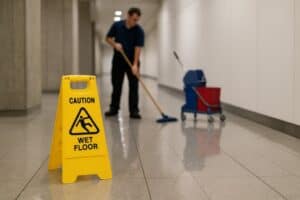Today, safety should never be treated as an afterthought. Among the many responsibilities businesses face, one area that often gets overlooked is floor maintenance. While it may seem minor compared to other safety protocols, maintaining clean and hazard-free floors can be the difference between a productive day and a costly lawsuit. Employees, visitors, and customers all interact with the flooring in a workspace, making it one of the most consistent points of contact—and therefore, one of the most important aspects of workplace safety. If an accident does occur, the consequences often extend beyond medical bills and lost workdays, sometimes requiring the involvement of a Personal injury attorney in Seattle. Preventing such scenarios starts with strong, proactive maintenance practices.
Why Floor Maintenance Matters in the Workplace
Preventing Slips, Trips, and Falls
The most obvious reason to implement floor maintenance protocols is to reduce the risk of accidents. Slips, trips, and falls remain one of the leading causes of workplace injuries across all industries. Something as simple as a spilled drink in a break room or a small patch of uneven flooring can result in a serious injury. These incidents not only cause harm to the individuals involved but also expose businesses to workers’ compensation claims, personal injury lawsuits, and increased insurance premiums. Regular maintenance and inspection greatly reduce these risks.
Building Confidence Among Employees and Visitors
First impressions matter, and so does the daily experience of employees. When people walk into a clean, safe, and well-maintained workplace, it signals professionalism and care. Workers feel more comfortable knowing their employer is proactive about safety, while visitors and clients see a business that values its reputation and pays attention to detail. This confidence fosters a stronger workplace culture and can even improve employee retention.
Meeting Legal and Regulatory Standards
Every business is subject to health and safety regulations, many of which include requirements for safe walking surfaces. Failure to comply with these standards can lead not only to lawsuits but also to fines from regulatory agencies. By implementing and documenting proper floor maintenance protocols, businesses show a clear commitment to compliance. That documentation, such as inspection logs, cleaning schedules, and training records, can serve as a strong defense if legal action ever arises.
Core Floor Maintenance Protocols Businesses Should Follow
- Routine Inspections
Conduct regular walk-throughs of the workplace to identify hazards. This includes checking for spills, loose tiles, frayed carpets, or any other surface irregularities that could lead to an accident. - Immediate Hazard Response
A small spill left unattended can quickly escalate into an injury. Staff should be trained and equipped to respond to hazards immediately. Wet floor signs, temporary barriers, or cordoned-off areas can keep people safe until the hazard is fully addressed. - Scheduled Cleaning Practices
Establish a routine cleaning schedule tailored to the needs of your workplace. High-traffic areas may need to be cleaned multiple times a day, while lower-use areas can be managed less frequently. Using the right cleaning agents is also important—harsh chemicals on the wrong flooring type can create slippery conditions. - Proper Signage and Safety Equipment
Warning signs are essential tools for communicating temporary hazards. Anti-slip mats at entryways, particularly during wet or snowy weather, can also reduce the risk of accidents. - Employee Training and Awareness
Safety is a shared responsibility. Regular training ensures all employees know how to identify hazards, use cleaning equipment properly, and follow emergency procedures. A well-trained staff can act quickly to prevent accidents before they happen.
The Legal and Financial Implications of Neglect
Ignoring floor maintenance can result in serious consequences. A single accident could lead to significant medical expenses, legal fees, and lost productivity. Lawsuits stemming from negligence often include claims for pain and suffering, long-term disability, or lost income—damages that can add up quickly. Beyond the financial costs, businesses also risk reputational harm, which can drive away clients, customers, and top talent.
In contrast, maintaining detailed logs of inspections, cleanings, and staff training provides a strong legal defense. These records demonstrate that the business made reasonable efforts to protect employees and visitors. In many cases, this can make the difference between liability and protection from a lawsuit.
Long-Term Benefits of Proactive Maintenance
Investing in floor care does more than prevent accidents—it pays off in the long run. Well-maintained floors last longer, saving money on repairs and replacements. Clean, polished surfaces also contribute to a more professional workplace appearance. Most importantly, a commitment to safety fosters trust within the organization. Employees who feel valued and protected are more productive, engaged, and loyal.
Final Thoughts
Workplace safety starts from the ground up, literally. While it may not be the most glamorous aspect of facility management, floor maintenance is one of the most practical and effective ways to prevent injuries and lawsuits. By prioritizing inspections, training, signage, and cleaning protocols, businesses safeguard not only their employees but also their financial health and reputation. And while there may be times when consulting a Personal injury attorney in Seattle is necessary, companies that implement proactive floor maintenance protocols are far less likely to find themselves in that position.
At the end of the day, safety is both a moral responsibility and a strategic advantage. A simple commitment to maintaining your floors can be the key to protecting people, reducing liability, and ensuring long-term business success.






